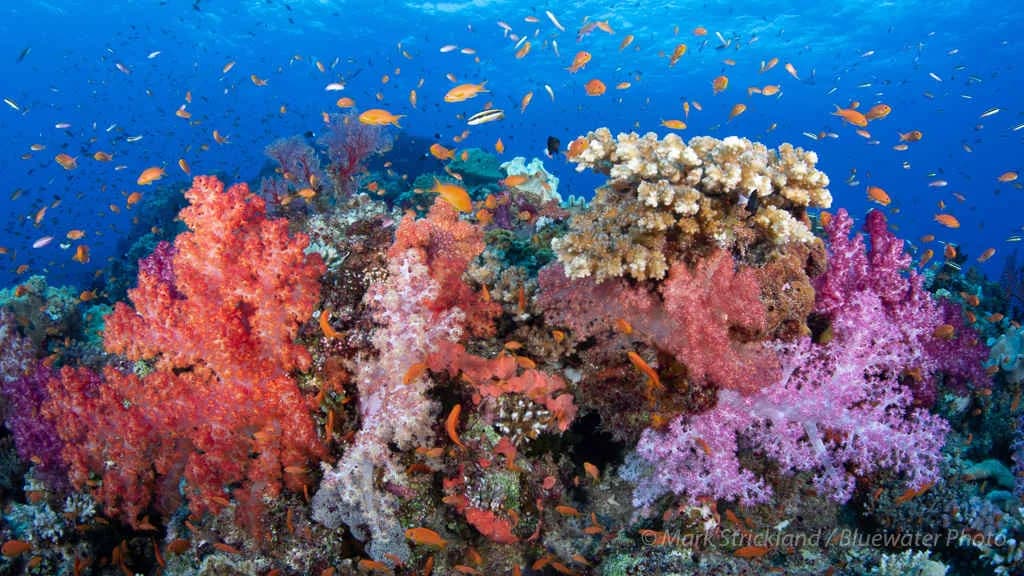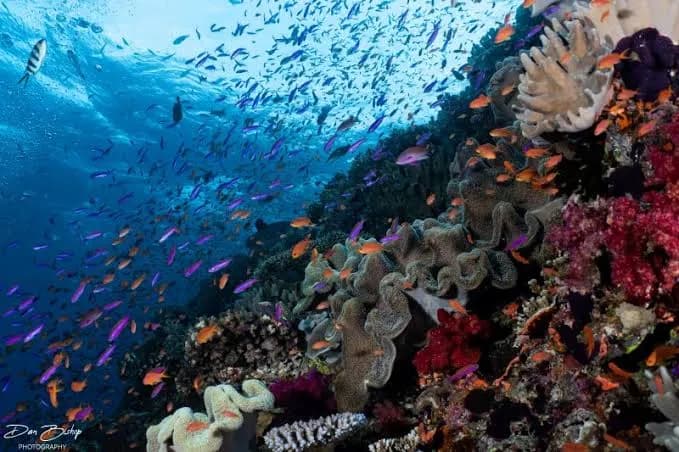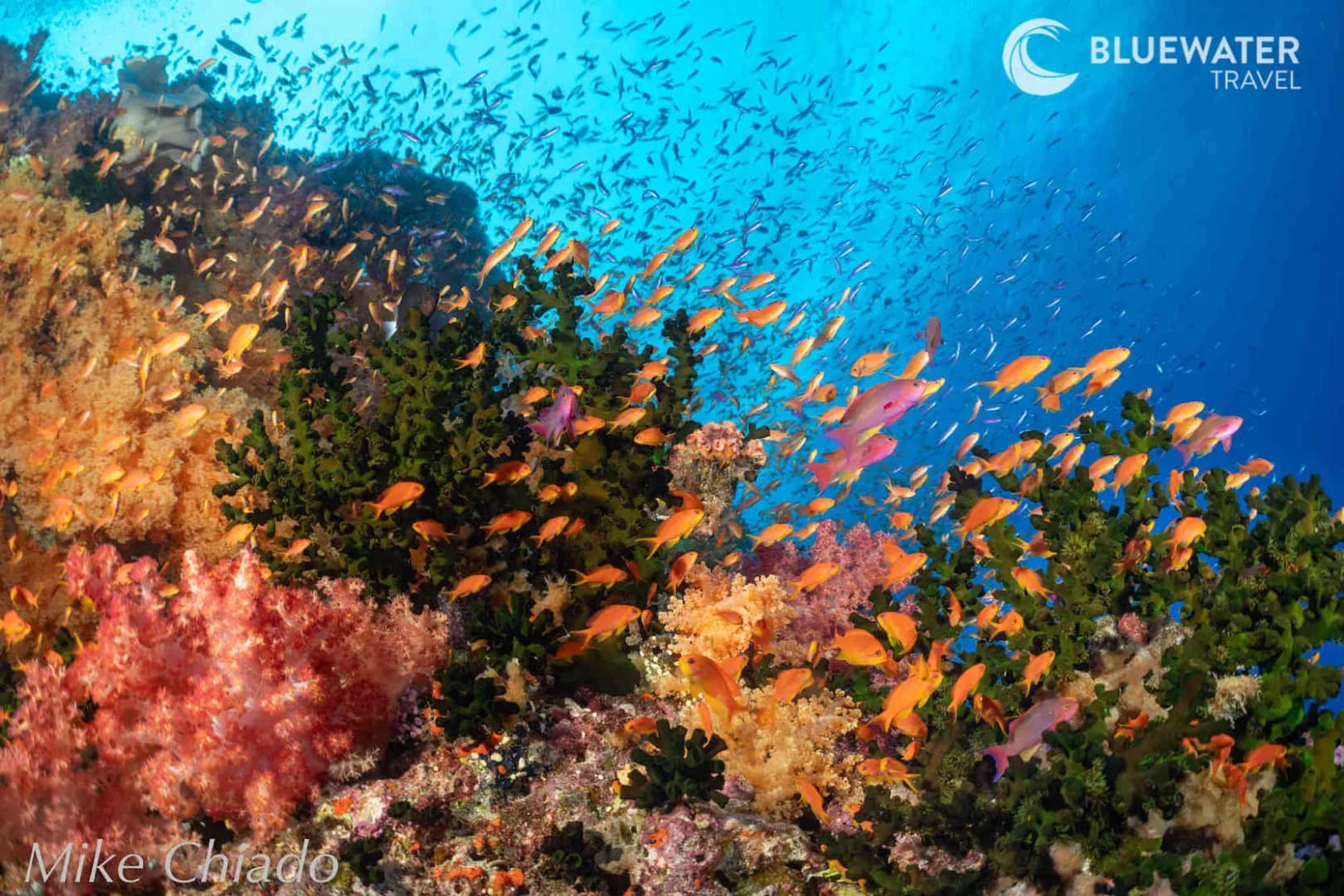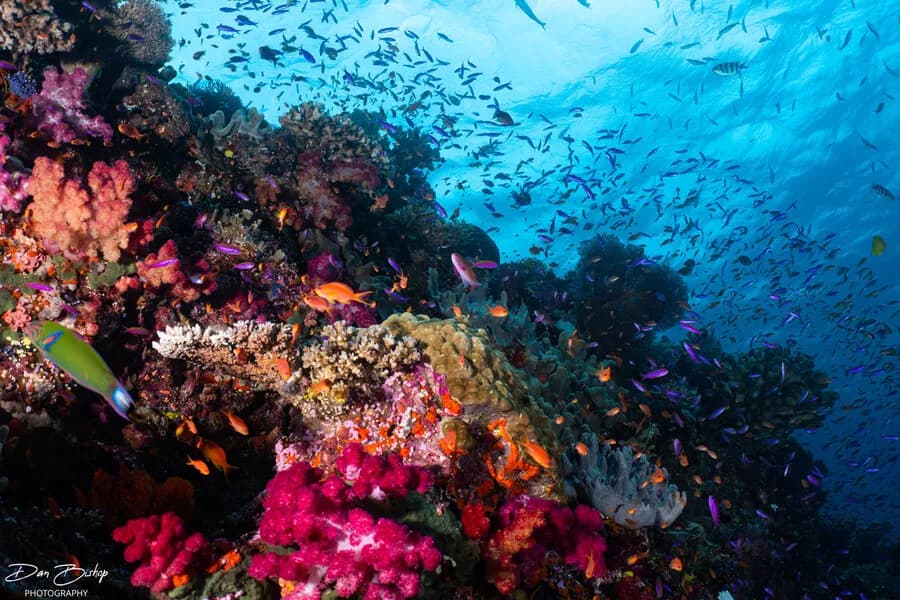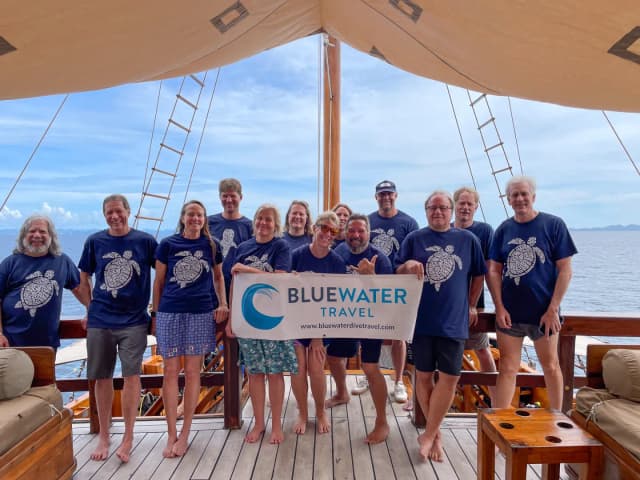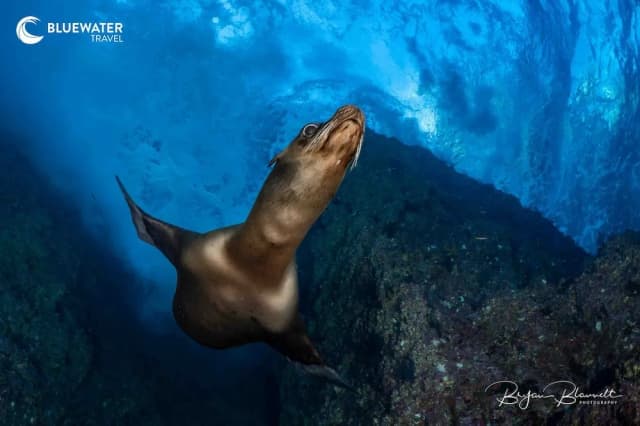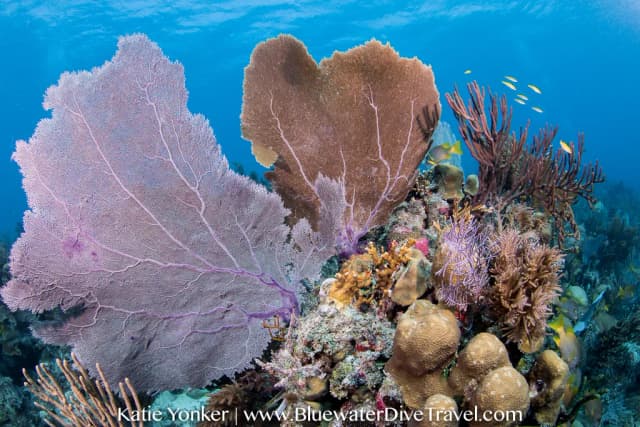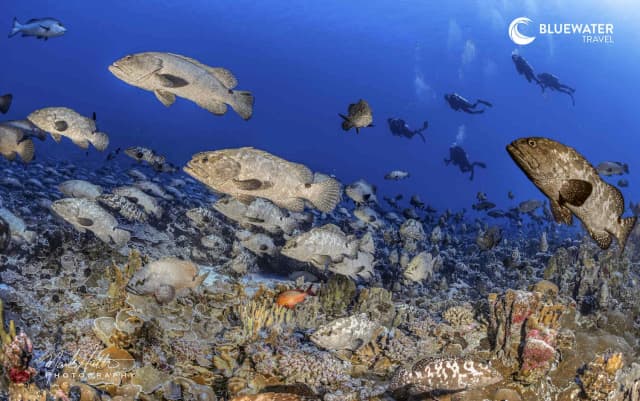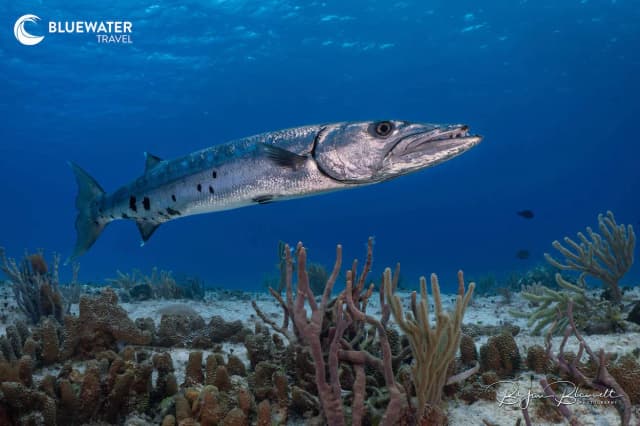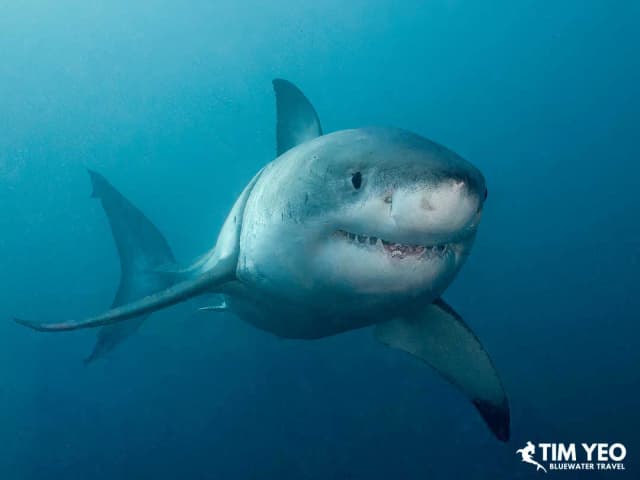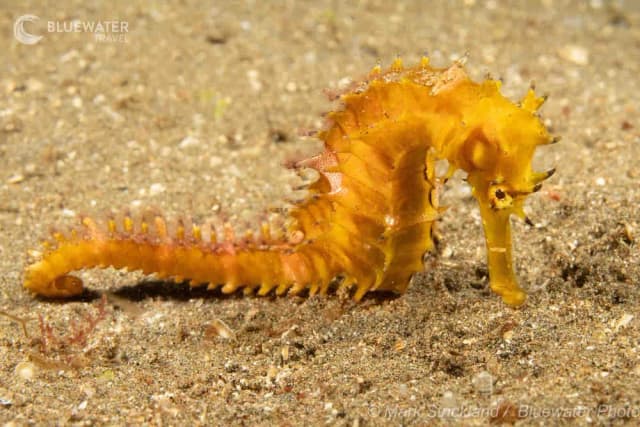Fiji Trip Report 2023
Bluewater Travel's 2023 Underwater Photography Workshop Aboard The Nai'a
Words and photos by Mark Strickland

There are some destinations that we all want to dive at least once, just to see how they compare to other places, see a certain creature, or check that box on our travel wish list. But there are also a handful of very special places that make you want to return again and again, and for me, Fiji belongs solidly on this short list. For sheer scenic beauty, healthy reefs, abundance and variety of marine life, and vibrant underwater colors, there is nothing quite like it. And as a bonus, its easy to access, safe, and boasts an incredibly friendly and welcoming local culture. Topping it off, our floating home on our recent trip was one of my very favorite liveaboards, the venerable Naia, which recently celebrated their 30th year of operation in these waters.


After boarding in early afternoon and being shown to our very comfortable cabins, cruise directors Bel and Mike gave us a comprehensive briefing on safety procedures, life onboard, and dive procedures. Dive gear was assembled, and soon it was time for the optional checkout dive, which was not a scenic reef, but did provide a chance to check our weighting and get reacquainted with diving for those who hadnt done so recently. After that, it was time for a crew introduction and the first of many delicious meals as we moved eastward towards the Bligh Water region, home to many of Fijis premier dive sites.
Fiji is on our list of the Best Coral Reefs in the World.



We awoke the next morning at a site that harkens back to the days before digital photography, named E-6, referring to the many rolls of film that were shot and processed on every visit here. The reef is actually the top of a seamount that rises from thousands of feet to nearly touching the surface, and is riddled with many ledges, crevices, and tunnels. The wall is covered with an assortment of corals and small sponges, and is home to a wide variety of reef fish and passing predators like bluefin trevally and dog-tooth tuna. But the feature that makes this site special is a network of passageways, the walls and floors of which are decorated with some very impressive fans and soft coral trees, some of which have bases the diameter of a persons calf!



For the afternoon, we moved a short distance to a truly spectacular site called Mount Mutiny, a football field-sized pinnacle which also rises from tremendous depths to within a few feet of the surface. The hard coral on top includes a range of branching and boulder varieties and provides shelter for a whole community of colorful reef fish, but the most eye-catching part of this dive is a section of vertical terrain known as Rainbow Wall that is populated with an infrequently-seen and super photogenic species of coral that is unlike the more familiar Alcynaria soft corals, in that it does not deflate when the current subsides. Its called Chironepthya, and occurs in a range of dazzling colors here including yellow, orange, pink and vibrant purple, often living side-by-side, along with delicate green tubastraea trees, occasional soft corals and large bushes of black coral. Being surrounded by such deep water, this site is regularly visited by large gamefish like wahoo, tuna and even marlin, along with occasional pelagic sharks like a 4 foot silky that we encountered on one dive. A few months before our trip, there was even a pod of sperm whales, accompanied by spinner dolphins and pilot whales!


Although few sites in the world can rival the color and beauty of Mount Mutinys Rainbow Wall, several reefs in the nearby Vatu-i-ra Marine Reserve could easily be said to. Here, we spent the next two days exploring a half-dozen or so sites consisting of coral bommies of various sizes and shapes that all top out at roughly safety-stop depth, making for perfect multi-level profiles. Bathed in currents that range from gentle to extremely vigorous, each of these sites is populated by thriving gorgonians and soft corals in deeper areas, with an increasingly high percentage of hard corals in the shallows. Fish life is outstanding in both diversity and quantity, with nearly every species in the book represented at one site or another. While sites like Charlies Garden and Alacrity feature mostly hard corals and Go Mo and The Whole Shebang have a bit of everything, arguably the most spectacular of all are Coral Corner and Mellow Yellow, where entire sections of reef are dominated by forests of pink, red and yellow soft corals, along with red whip corals and orange fans, velvety-green tubastrea trees, and in some areas, the same purple and yellow Chironepthya colonies seen at Mount Mutiny. Swarming around these corals, especially when the current is running, are clouds of pink and orange anthias fish, along with a huge variety of wrasses, damselfish, butterflyfish, surgeonfish and many others. Larger fish also make regular appearances here, including bottom-dwelling groupers and snappers, as well as mid-water predators like Spanish mackerel, green jobfish and various trevallies. During one dive at Coral Corner, we watched in awe as a large red snapper teamed up with a white-tip reef shark and a pair of gray reef sharks to terrorize the reef fish on the edge of a deep slope, putting on quite a show! Another highlight was at the end of a mellow dive at the often current-prone site called Maytag, where we were surrounded for several minutes during our blue-water safety stop by a huge school of queenfish, a species that Ive previously only seen in twos and threes.



Our fifth day was spent at Wakaya, where we alternated between sites known as Blue Ridge and Lions Den. The main attraction here is the possibility of mantas, as they often show up to rid themselves of parasites, courtesy of the resident cleaner wrasses. Despite both of our groups waiting patiently, however, by the end of the second dive, no mantas had shown up. We did see a lot of other great stuff though, including 3 yellow leaf scorpionfish, a giant moray, squarespot and purple queen anthias, several pairs of decorated dartfish, a school of roughly 30 coronetfish, and a clown triggerfish being shadowed by an orange-spotted trevally. And, a few lucky divers got a glimpse of several scalloped hammerheads and even a lone great hammerhead! Topping it off, that afternoon, just as it looked like the winged giants would be a no-show, two nearly all-black mantas showed up and made a number of close passes over about 30 minutes while being serviced by resident cleaner wrasses. Those who did the night dive reported a good variety of reef creatures and mid-water swimmers, along with a rare sighting of a pearlfish outside of its sea-cucumber home.



The next day found us at the island of Gau, where one group dived Jims Alley as the other explored Anthias Avenue. Conditions were great at both sites, where a series of current-swept pinnacles attracts an excellent variety of reef fish at all depths, including lemon peel and three-spot angelfish, fields of garden eels, scissortail and bicolor dartfish and pairs of endemic bi-color rabbitfish. Periodically, squadrons of bluefin and orange-spotted trevallies came charging past, along with occasional Spanish mackerel, as dense schools of fusiliers and anthias all but blotted out the sun at safety stop depth. Our second morning dive took us to Gaus outer reef, where both skiffs covered different sections of same site, on the offshore side of Nagali Passage. Here we explored a gentle hard coral slope populated by a great variety of small and medium size reef fish including lunar-tail grouper, blue-head tilefish, lots of magnificent dartfish, longnose filefish, regal angelfish, and countless others. The star attraction this day, however, was Nagali Passage itself, where the skiffs departed at 15 minute intervals to avoid crowding, then began the dive with an effortless drift through the narrow passage that connects to the inner lagoon. Flying along with the current in mid-water, we enjoyed watching schools of barracuda and individual gray reef sharks in excellent visibility until reaching a spot where the channel splits, at which point we all took our places at the Bleachers, a ledge at about 50 feet thats a perfect spot to stop and watch an ongoing parade of gray reef sharks, ranging from 18-inch juveniles to 6 foot adults. Complementing the scene are several bommies covered with spectacular soft corals and a huge school of resident midnight snapper. As time and air dictated, we finished the dive with another free ride to safety stop depth at the end of the pass, where theres a massive formation of near-perfect cabbage coral known as the Cabbage Patch truly a memorable dive!


In lieu of the afternoon dive, most of the group went ashore to visit a small community called Somosomo Village, which turned out to be a real highlight. Clad in the colorful sulus (sorongs) that were provided for us, we waded ashore as a small welcoming committee greeted us with smiles and handshakes. Two of the residents took us for a guided tour of their village, including a well-appointed one-room schoolhouse, where the youngest children begin their education. Older kids attend boarding school on a different island, returning home every weekend, so the village was relatively quiet, yet still seemed to be humming with activity. We were then shown to a spacious structure that serves as community center, where we were welcomed with a lovely prayer, followed by a lively series of traditional songs and dancing. At one point, we were invited to join in the festivities, which many guests did with great enthusiasm. After everyone had gotten their fill of dancing, each of us was offered coconut shells filled with kava, a mildly narcotic beverage made from the roots of a pepper plant. The appearance and taste is reminiscent of muddy water, but the effects are quite pleasant, causing a slight numbness of the lips as it is consumed. The villagers were very curious about each guests background, and some very nice conversations ensued as we sat around the kava bowl. As the sun set, we headed back to Naia as the entire community stood on the beach waving goodbye.
Our next two days were spent in the celebrated Namena Marine Reserve, where we alternated between stunning drop-offs, thriving pinnacles and uber-healthy coral gardens. Among the favorite sites was Grand Central Station, where we descending into the deep blue in very clear water and were immediately surrounded by schooling red-tooth triggerfish. Several gray reef sharks and dog-tooth tuna circled in the distance as we drifted closer to the top of the wall, where valleys of white sand bottom were punctuated with a series of coral-covered bommies. In addition to all the usual reef fish, we were treated to encounters with several infrequently seen species, including a pair of intermediate-size African pompano (threadfins) and a contingent of milkfish, which are normally seen only near the surface. A huge archway loomed in the distance as we explored among a forest of beige gorgonian corals, while a school of bigeye jacks circled above. Continuing on towards the next bommie, several divers encountered a lone scalloped hammerhead, casually swimming through the pass towards the dropoff. Turning our attention back to the reef, we watched a very relaxed hawksbill turtle browsing among the corals, keeping one eye on us divers while it went about its business. Ascending towards the shallows revealed a thriving reef community decorated with vibrant soft corals and crinoids, complimented by pulsating schools of scalefin anthias, damselfish and clusters of blue palette surgeonfish that stayed just out of photo range, but still added to the visual feast at the reef-top. The most exciting moment of the day, however, happened as divers from the other skiff, who were also diving G.C.S. at a slightly different time, ascended to do their safety stop on the edge of the wall. It was an encounter so rare that most divers, even those with thousands of dives under their belt will never experience, as 5 six-foot sailfish approached the group and circled for several minutes, even coming within photo range a few times!


Another great Namena site is School House, an appropriately-named drop-off where we spent most of our dives surrounded by massive schools of bigeye jacks, barracudas, pinjalo and midnight snappers, red-tooth triggerfish, surgeonfish, and occasional dog-tooth tunas and green jobfish, along with several scalloped hammerheads and an amazingly dense school of bannerfish, each displaying their distinctive dorsal plumes, several times their own body length. As bottom time dictated a move to the shallows, vibrant soft corals and gorgonians became more prevalent, complemented by a wide variety of hard corals. Lurking under an overhang were two large saddleback grouper, one of which was the typical drab coloration of the adult phase, while the other one still displayed striking sub-adult markings, with dark vertical bars on a white background, accented by bright yellow tail and fins.


Kansas is another iconic Namena site, where a pair of windows in a small pinnacle are surrounded by soft corals and fans, often complimented by a pair of bannerfish. The top of this same pinnacle is covered with what may be the worlds largest colony of Sinularia soft coral, which with their tan-colored branches waving in the current, evoke visions of a wheatfield in the American mid-west, hence the sites name. On the same pinnacle, a shallow finger of fossil coral is covered with soft corals and surrounded by schooling anthias, with a pair of resident bluespotted grouper standing guard.
Rounding out the assortment of notable Namena sites were Magic Mushrooms and Two Thumbs Up. Both sites are comprised of twin pinnacles, and both were super colorful and fishy, and also boasted a wide range of invertebrates, including colorful sponges, crinoids, sea stars, cowries, flatworms and several species of nudibranchs and shrimp.



Our second morning at Namena featured a return to the awesome sites of Schoolhouse and Grand Central Station, with most of the same fish species being present in similar abundance as the preceeding day. For the afternoon, however, we moved over to a pair of pinnacles, Titon 1 and Titon 2. The first is a single small, near-perfect cylinder, covered with an assortment of soft corals, fans and green tubastraea trees. The perimeter of the pinnacles base is home to numerous pairs of bluehead tilefish and a juvenile ribbon eel, while the sides are populated by a huge assortment of reef fish including freckled hawkfish, semi-circle, regal and lemonpeel angelfish, many varieties of butterflyfish, and several pairs of orange-fin clownfish among the tentacles of their anemone hosts. Titons 2 is a similar but shallower bommie that tops out at 15 feet, making for a perfect multi-level dive. Here, we saw another juvenile ribbon eel, a young giant moray being cleaned, several different nudibranch species, and a giant mantis shrimp near the pinnacles base. Spiraling slowly upward, a constant parade of colorful reef fish greeted us at every depth, including regal and emperor angelfish, juvenile yellowtail coris, longnose hawkfish, and bird wrasse. The vertical sides are covered with a wealth of beautiful soft corals, while the reef top was buzzing with reef fish including lots of unicornfish, anthias and fusiliers it felt like being in a living fish soup!


Kava Time! After dinner, rather than preparing for a night dive, the crew spread out woven mats on the dive deck and broke out musical instruments in preparation for what is always a highlight - an onboard kava session! Nearly all the guests participated, taking turns between singing along with the crew, clapping in time with the music, and sampling kava from coconut shells. Lots of laughs and a good time had by all!
The next day found us at an area known as Vuya, where we took turns exploring yet another premier dive site - Cats Meow - named in honor of Naia co-owner Rob Barrels wife Cat, to whom Rob proposed here years ago. It was easy to see why this site struck them as special, as nearly every inch of this compact, cylindrical-shaped bommie is covered with thriving, colorful marine life. Rising nearly to the surface from about 70 feet, there is great scenery at every depth, but the highlight is at the bottom, where a forest of purple soft coral trees sprouts from the rubble substrate. The base of the pinnacle is riddled with countless crevices, overhangs and holes as well as several tunnels, all of which are decorated with colorful soft corals and fans. Its worth moving slowly here, however, to avoid disturbing the large many-spotted sweetlips that inhabit these swim-throughs.


Close to Cats Meow is another outstanding site called Humann Nature, named for fish I.D. expert and dive industry pioneer Paul Humann. Considerably larger than most of the pinnacles wed been diving, this site consists of a massive bommie covered with mostly hard corals, along with a few fans and translucent soft corals. The steep topography here makes for interesting scenery, but the real attraction is the fish life, featuring an incredible variety of candy-colored tropicals, including leopard and slingjaw wrasse, peacock grouper, Moorish idols, and several yellow trumpetfish hunting schooling anthias. Just as we were ending our dive, a small hawksbill turtle also made an appearance, ascending for a breath at the reef top.

Our afternoon dives were spent at UndeNAIAble, a large hard coral reef with several deep crevices, the walls of which are decorated with pastel soft corals and large red gorgonian fans. Exploring with the mini-wall on our right, the bottom eventually shallowed up to 40 feet or less, where a cluster of small bommies support a wide range of hard corals at 15 feet or less, making for a very scenic safety stop. This was also the scene of our night dive, which featured several 3 ft. worm-like segmented sea cucumbers, a large cone shell, hundreds of shrimp, sleeping parrotfish, and a pair of imperial shrimp on a leopard sea cucumber.



The very best sites are always worth repeating, so it was with great excitement that we moved back to the fabulous Vatu-i-ra Marine Reserve for our final day of diving. For the first dive, we took advantage of unusually gentle conditions to explore the normally high-current sites of Maytag and GoMo. In both cases, there was just enough water movement to keep things interesting with lots of schooling fish action and occasional visits by patrolling dog-tooth tuna, while allowing exploration of the entire site with no particular effort. And at Maytag, Bel discovered a pair of rare Phylodesmium undulatum nudibranchs on a gorgonian fan. Then, for the final two dives of the trip, our groups alternated between the two most colorful sites of all, Mellow Yellow and Coral Corner. Both easily lived up to our very high expectations, with just enough current for plenty of activity. At both sites, larger fish like yellow emperors, marble grouper and whitetip reef sharks patrolled the deeper slopes, as mid-water predators like Spanish mackerel and orange-spotted trevally made regular passes. Colorful reef fish of many species made their rounds, cleaner wrasses serviced their fidgety customers, vibrant soft corals lifted their branches into the water column, and the entire reef-top pulsated with the frenzied feeding activity of clouds of orange and purple anthias, contrasting beautifully with the clear blue water, making for fantastic wide angle photo opportunities. It was a fitting note for our last dive of the trip, and a vision that will live on in my minds eye until my next visit to Fiji, for which I can barely wait!

Want to learn more about diving in Fiji? Read our 2022 Fiji Trip Report.
Join Us On Our Next Trip To Fiji!
NOVEMBER 23 - DECEMBER 3, 2024
10 Nights for $6,684 per person, double occupancy*
Trip Leader: Erik Lukas
